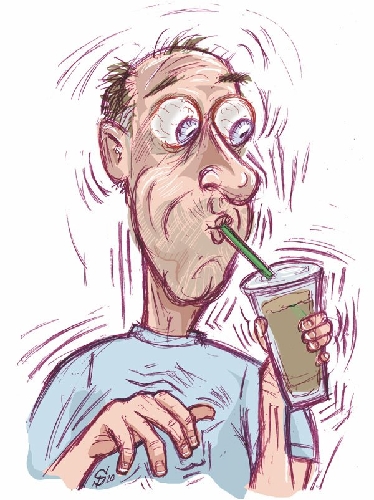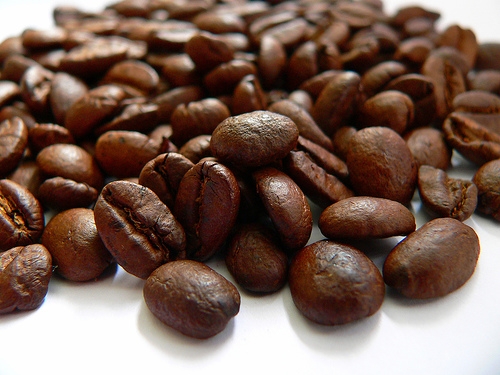A Jittery, Jumpy Jolt
Most are aware that drinking too much coffee can make us jittery, interrupt sleep cycles and even cause headaches. But we can consume too much caffeine from other sources without even realizing it. Mary Wilson has done it -- and she's a registered dietitian.
"I go through that myself every once in a while because I actually like Diet Coke, but it's hard to find the caffeine-free stuff," said Wilson, who's an extension nutrition specialist with University of Nevada Cooperative Extension. "Then I'll get a regular Diet Coke and wonder why I didn't sleep well that night."
Joanna Gorman, a registered dietitian at University Medical Center, said there's only about 40 milligrams of caffeine in eight ounces of most soft drinks, well below the 200 milligrams that she said is considered an acceptable daily maximum "for just about anybody, even for pregnant women."
But a can of soft drink generally contains 12 ounces, so that bounces it right away to 60 milligrams. Have several of those a day -- or, like Wilson does, get a large cup of it at a convenience store, "which is almost three or four cans of Diet Coke; no wonder it gives me a buzz" -- and the numbers add up.
"I think a lot of people don't always look at how much caffeine is in their soft drinks," said Sandhya Wahi, an internal-medicine physician and the residency program director for internal medicine at the University of Nevada School of Medicine. "There's quite a bit of variability in that particular source. Some have small amounts -- as low as 10 milligrams -- but depending on the size of the can or the bottle, sometimes they have quite large amounts."
Wilson noted that while most people are aware that colas contain caffeine, and may know about big caffeine sources such as Mountain Dew, they may not realize that other soft drinks that contain it include A&W Cream Soda, Sunkist orange soda, Barq's Root Beer and Dr Pepper.
And even water, sometimes. Wilson found that Glaceau Vitamin Water Energy Tropical Citrus contains 50 milligrams of caffeine.
"The water thing kind of caught me off balance," she said. "I wouldn't have thought I'd have to worry about that."
Wilson said she thinks most people are aware that energy drinks contain a lot of caffeine, as well as such energy products as Jolt chewing gum (33 milligrams per stick) and Foosh energy mints (100 milligrams per tablet). But Jim Swift, medical director of Sunrise Children's Hospital, said that often, people don't consider just how much caffeine they're consuming in them.
"We know that there's been a big increase in the consumption of these energy beverages and other beverages that are thought in most of the pediatric population to be innocuous, fun drinks," Swift said. But in contrast to a soft drink, he said, energy drinks can have anywhere from 55 to 200 milligrams in a 12-ounce serving. (A 5-Hour Energy drink, he said, has about 150 milligrams "in that small, little, 2-ounce, 3-ounce serving.") High school-age students, especially, think "it's cool and hip to use," he said, and many are ingesting five to 10 times the amount of caffeine they would have five years ago.
But caffeine increases heart rate, which can be a problem in the case of an undiagnosed arrhythmia. And while many teens think energy drinks will make them more alert, caffeine instead creates more problems with their ability to maintain focus.
And they can be particularly hazardous to athletes. At higher doses, Swift said, caffeine is a diuretic and can cause significant dehydration. If an athlete has two or three energy drinks in an afternoon, thinking they will lead to better hydration, "it's actually the contrary. It leads to more net water loss than actual water gain from the beverage. It's a significant issue, especially in the hot summer months."
Beyond the jitters, interrupted sleep and potential unknown heart problems, Wahi said, consuming too much caffeine can cause chronic migraines and high blood pressure.
"It can affect your bones if you're a chronic user and take it long term -- can cause osteoporosis," she said.
(Then again, Wahi said, research has shown that "small to moderate" consumption of caffeine can improve athletic performance, decrease incidence of diabetes and possibly reduce incidence of Alzheimer's and Parkinson's diseases, although the data on those is slim.)
While people talk about caffeine addiction, Wahi said chronic overuse actually is a dependence. Withdrawal symptoms, she said, can include headaches, fatigue, lack of energy, sleepiness, lack of concentration or irritability.
Besides beverages, Wilson said, caffeine is in a lot of foods we don't think about, such ass coffee ice cream. Ben & Jerry's Coffee Heath Bar Crunch has 84 milligrams in 8 ounces, she said. And while a 1½-ounce Hershey bar has only 9 milligrams, Hershey's Special Dark has 31 milligrams.
"Or we don't think about that Excedrin we took for a headache that has 130 milligrams in two tablets," she said.
Unless you have specific medical conditions, you don't need to cut caffeine out of your life, but you may want to be aware of how much you're consuming.
"I think it was making me very restless; I always felt like my mind was too active at night," Wilson said. "I was just buzzed, when I quit drinking it, I slept better.
"I can have a can of Diet Coke. As long as I do it not a whole lot past noon, I'm OK."
Contact reporter Heidi Knapp Rinella at hrinella@reviewjournal.com or 702-383-0474.


















